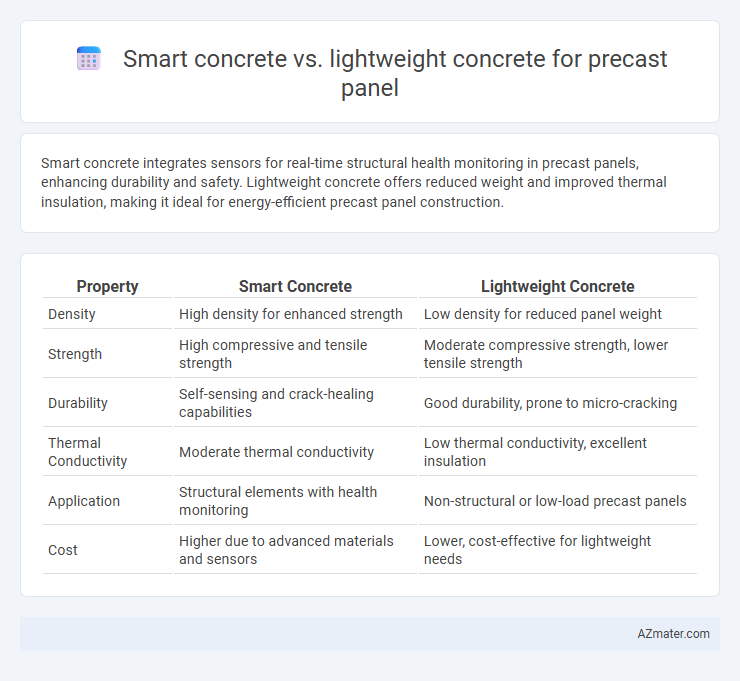Smart concrete integrates sensors for real-time structural health monitoring in precast panels, enhancing durability and safety. Lightweight concrete offers reduced weight and improved thermal insulation, making it ideal for energy-efficient precast panel construction.
Table of Comparison
| Property | Smart Concrete | Lightweight Concrete |
|---|---|---|
| Density | High density for enhanced strength | Low density for reduced panel weight |
| Strength | High compressive and tensile strength | Moderate compressive strength, lower tensile strength |
| Durability | Self-sensing and crack-healing capabilities | Good durability, prone to micro-cracking |
| Thermal Conductivity | Moderate thermal conductivity | Low thermal conductivity, excellent insulation |
| Application | Structural elements with health monitoring | Non-structural or low-load precast panels |
| Cost | Higher due to advanced materials and sensors | Lower, cost-effective for lightweight needs |
Introduction to Precast Panels
Precast panels are modular construction elements manufactured off-site, enabling faster installation and consistent quality control. Smart concrete integrates advanced materials and sensors to enhance durability and monitor structural health in real-time, making it ideal for high-performance precast panels. Lightweight concrete reduces panel weight, improving handling and transportation efficiency while maintaining adequate structural strength for various building applications.
What is Smart Concrete?
Smart concrete incorporates advanced materials such as carbon fibers or conductive nanoparticles to enable self-sensing, self-healing, and real-time structural health monitoring in precast panels, enhancing durability and safety. Lightweight concrete, in contrast, uses aggregates like expanded clay or shale to reduce the panel's weight and improve thermal insulation but lacks intelligent functionalities. The integration of smart concrete in precast panels optimizes maintenance efficiency and extends structural lifespan through embedded sensors detecting stress or damage early.
What is Lightweight Concrete?
Lightweight concrete for precast panels is a specialized building material composed of lightweight aggregates such as expanded clay, shale, or slate, which reduce the overall density while maintaining structural strength. This type of concrete offers enhanced thermal insulation, improved fire resistance, and easier handling during manufacturing and installation compared to traditional normal-weight concrete. Its lower weight reduces transportation costs and structural load on buildings, making it a preferred choice for precast panel applications where efficiency and performance are critical.
Composition Differences
Smart concrete incorporates advanced materials such as nanomaterials, sensors, and self-healing agents that enhance durability and monitor structural health, while lightweight concrete primarily consists of lightweight aggregates like expanded clay or shale to reduce density and improve thermal insulation. The composition of smart concrete integrates conductive elements and polymers for real-time data transmission, contrasting with lightweight concrete's focus on optimizing aggregate properties to balance strength and weight. These fundamental differences in material components define their distinct functionalities in precast panel applications.
Key Performance Properties
Smart concrete enhances precast panel performance with self-healing, stress-sensing, and temperature-responsive properties, providing durability and structural health monitoring. Lightweight concrete offers reduced density, improved thermal insulation, and ease of handling, contributing to energy efficiency and faster construction. Both materials optimize precast panel applications by balancing strength, weight, and functional intelligence for targeted construction needs.
Structural Strength Comparison
Smart concrete for precast panels incorporates advanced materials like fiber reinforcement and nanomaterials, significantly enhancing tensile strength and crack resistance compared to traditional lightweight concrete. Lightweight concrete, while reducing overall panel weight through components like expanded clay or foam, typically offers lower compressive strength and durability under load stress. Structural strength evaluations reveal smart concrete panels deliver superior load-bearing capacity and longevity, making them ideal for high-performance precast applications.
Durability and Longevity
Smart concrete incorporates sensors that monitor structural health, enhancing durability through real-time data on stress and cracks, which helps prevent premature failure in precast panels. Lightweight concrete offers benefits in reduced weight and thermal insulation but often has lower compressive strength and higher porosity, potentially decreasing long-term durability when exposed to harsh environmental conditions. Selecting smart concrete for precast panels ensures greater longevity by enabling proactive maintenance, whereas lightweight concrete requires careful design adjustments to maintain durability over time.
Sustainability and Environmental Impact
Smart concrete enhances sustainability in precast panels through self-healing properties that extend structural lifespan and reduce maintenance, lowering lifecycle environmental impact. Lightweight concrete minimizes carbon footprint by using less raw material and improving thermal insulation, which decreases energy consumption in buildings. Combining these technologies can lead to eco-friendly precast panels that optimize both durability and energy efficiency.
Cost Implications in Precast Panel Production
Smart concrete incorporates advanced materials like sensors and self-healing agents, leading to higher initial costs but long-term savings via reduced maintenance in precast panel production. Lightweight concrete offers lower material and transportation costs due to its reduced density, enhancing cost efficiency but potentially compromising durability in structural applications. Evaluating cost implications requires balancing upfront investment in smart concrete against the economic benefits of lightweight concrete's ease of handling and faster production cycles.
Best Applications: Choosing the Right Concrete
Smart concrete, embedded with sensors for real-time monitoring of structural health, excels in high-performance precast panels used in critical infrastructure where durability and data-driven maintenance are paramount. Lightweight concrete offers superior thermal insulation and reduced dead load, making it ideal for precast panels in residential and commercial buildings that demand energy efficiency and ease of handling. Selecting the right concrete depends on project priorities: smart concrete suits infrastructure with monitoring needs, while lightweight concrete supports applications prioritizing weight reduction and thermal performance.

Infographic: Smart concrete vs Lightweight concrete for Precast panel
 azmater.com
azmater.com